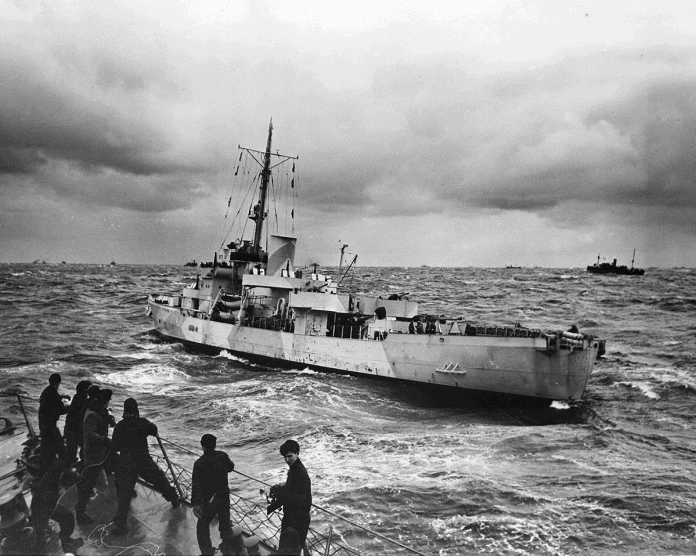
December 7, the date of this edition of The Cordova Times, is, in the immortal words of President Franklin Delano Roosevelt, “a date that will live in Infamy”.
On that day in 1941, the sneak attack on Pearl Harbor led to this country’s entry into World War II, and a global conflict it was, indeed.
Many do not realize or recall that Alaska was the only part of the United States invaded by foreign powers during that war, with the battle to dislodge Japanese forces from the Aleutian Islands titled “The Forgotten War.”

USCG photo
The Battle of Attu, which took place in May 1943, was the first amphibious island invasion by the U.S. Army in WWII, and also the costliest per troops involved in the Pacific Theatre during the war.
Right here in our neighborhood, the airport at Mile 13 was built by the U.S Army prior to and during the early stages of WWII; a railway tunnel to haul supplies to military bases in Anchorage and beyond was blasted through mountains near Whittier; and Smith Island, located in the center of Prince William Sound with a view of all the major entrances, was the site of several gun emplacements to protect against invading ships.
The old gun turrets outside the entrance to the Coast Guard Air Station at Mile 13 serve as a reminder of that air field’s WWII significance.
As major ports in the Sound, both Valdez and Cordova served as part of the war effort.

Photo courtesy Ekemo family collection
An amazing set of black and white photos recently discovered in an old album that belonged to John and May Ekemo, my wife’s parents, shows U.S. submarines and destroyers near the docks in Valdez during the war.
John was born and raised in Valdez, and May arrived there as a nurse in 1944. Who took the photos is not clear, but evidently security was not too strict at that time, as the names of the two submarines can be clearly seen on their bows. Their history is fascinating.
The black-hulled 340-foot USS Bass was launched in 1924, and had been decommissioned in 1937, only to be re-activated in 1940 as part of the war effort. After brief war patrol service near the Panama Canal until 1942, she was converted and utilized as a cargo submarine before being decommissioned and sunk as a target in testing of new torpedoes in March 1945.
The 349-foot USS Nautilus was launched in 1930, and had a distinguished record, serving in 14 different long-range patrols throughout the war, beginning with the Battle of Midway in 1942.

Photo courtesy Ekemo family collection
Nautilus received the Presidential Unit Citation and 14 battle stars for her service throughout the Pacific. Not only was she credited with sinking numerous ships, she also served as a troop transport for the Marines in the Makin Atoll Raid in 1942.
In early April 1943 the Nautilus left Pearl Harbor headed north for Dutch Harbor, where she picked up 109 Infantry Scouts, including Alaska Native Scouts of the Alaska Territorial Guard, that were landed on Attu five hours prior to the main assault there against Japanese forces.
Like many other ships following the end of WWII, the Nautilus was decommissioned and sold for scrap, in this case in November of 1945.
The size of the two WWII subs was startling. If placed on a football field, they would stretch from goal post to goal post.

USCG photo
The name Nautilus was to live on. The world’s first operational nuclear-powered submarine, launched in 1954, was named Nautilus in her honor. This pioneer of the Navy’s nuclear fleet became famous for being the first submarine to complete a submerged transit of the North Pole in August 1958. The Nautilus was decommissioned in 1980 and is preserved at the Submarine Force Museum in Groton, Connecticut, where it receives around 250,000 visitors a year.
Meanwhile, a USCG ship that was stationed in Cordova from 1937 to 1940 also gained considerable war fame. The Spencer was a 32-foot cutter commissioned in 1937 and named for U.S. Treasury Secretary John Canfield Spencer. She left Cordova to provide escort for conveys crossing the North Atlantic and was responsible for sinking German submarine U-175 in 1943. Later she was assigned to the U.S. Navy’s Seventh Fleet in the Pacific, where she served as a communications command ship during the invasion of the Philippines.
After the war, Spencer returned to Coast Guard duties in the Atlantic, and then back to combat duty off the Vietnam coast in 1969, where she carried out surveillance to prevent troops and supplies from getting into South Vietnam.
The Spencer served over 37 years, and when decommissioned in 1974, was the most decorated cutter in the Coast Guard’s fleet.
Following a Coast Guard tradition, a new 270-foot medium-endurance cutter commissioned in 1986 was named the Spencer. It remains in active service to this day.

U.S. Navy photo














